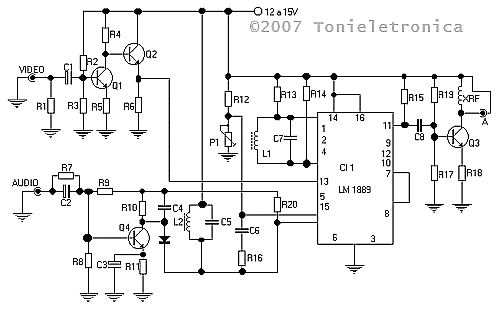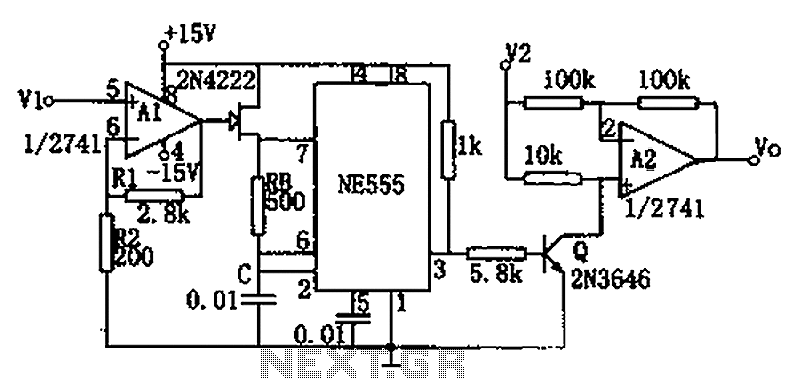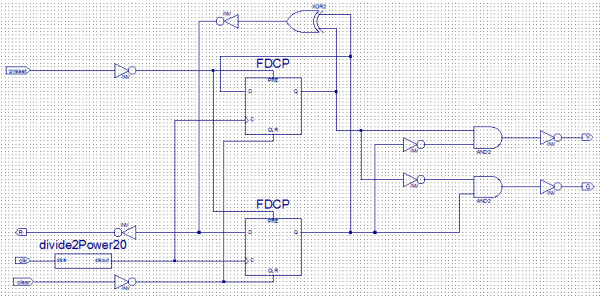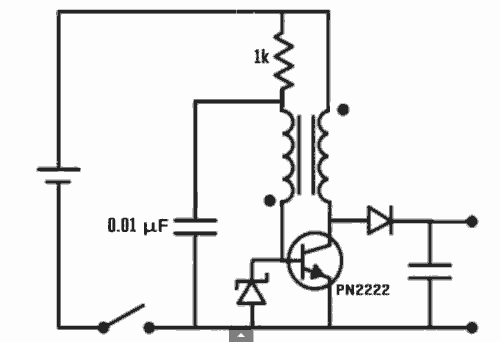
FM radio circuit by the FET composed
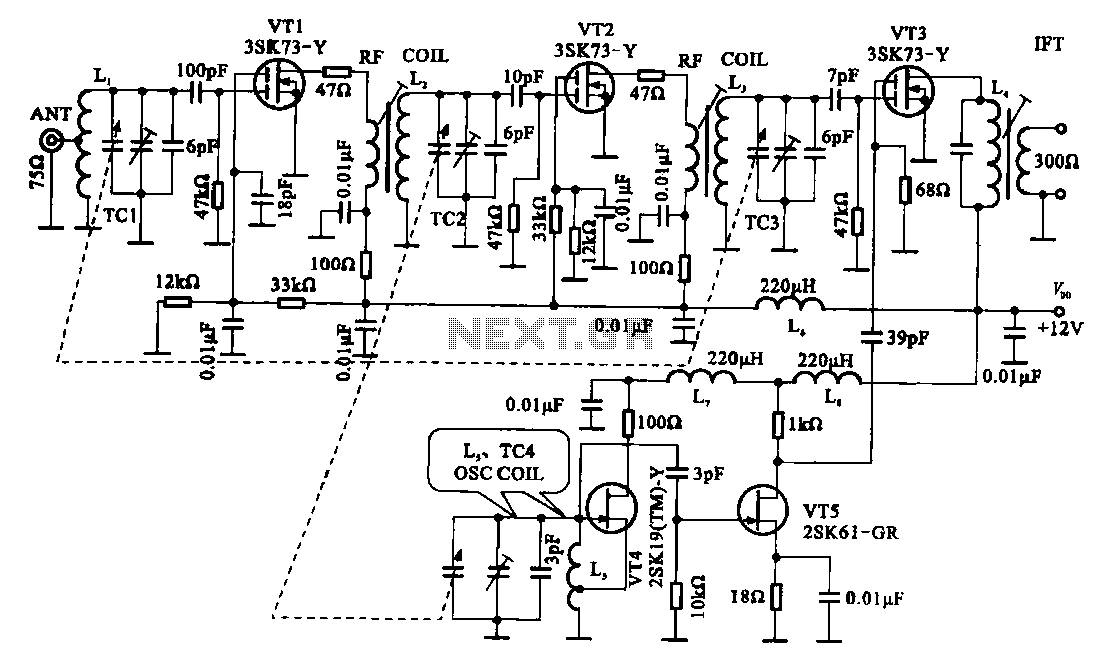
The FM radio circuit is represented by a double-gate MOS field-effect transistor. The high-frequency amplifier is a bipolar MOS field-effect transistor amplifier consisting of transistors VT1 and VT2. VT3 serves as the mixer. The local oscillator is formed by VT4, with the high-frequency signal applied to the first gate. An LC circuit is tuned to the selected frequency after the gate VT1, where a high-frequency signal is amplified by the RF coil, which is coupled to the second stage of high-frequency amplification. This second stage includes an input terminal and an LC resonant frequency selection circuit. Following the two-stage high-frequency amplification and frequency selection circuit, the signal is sent to the first gate of the mixing stage, VT3. The local oscillator signal generated by VT4, after amplification, is applied to the mixer stage, VT5, on the second gate. The intermediate frequency (IF) signal formed after mixing (10.7 MHz) is output from the intermediate frequency transformer (L4).
The FM radio circuit utilizes a double-gate MOS field-effect transistor configuration to achieve efficient high-frequency signal processing. The circuit begins with the input signal being processed by the high-frequency amplifier, which is realized through a combination of transistors VT1 and VT2. These transistors work together to amplify the incoming radio frequency signals, ensuring that they are strong enough for further processing.
Transistor VT3 acts as a mixer, combining the amplified RF signal with a local oscillator signal generated by transistor VT4. The local oscillator is critical for frequency conversion, allowing the circuit to down-convert the incoming RF signal to an intermediate frequency (IF) for easier processing. The LC circuit, positioned after gate VT1, is crucial for tuning the circuit to the desired frequency by selectively allowing specific frequencies to pass while attenuating others.
The RF coil plays a significant role in this amplification stage, coupling the output of the first stage to the second high-frequency amplification stage. This stage includes an LC resonant frequency selection circuit, which further refines the signal by ensuring that only the desired frequencies are amplified. After this two-stage amplification, the signal is routed to the first gate of the mixing stage, where it is combined with the local oscillator signal from VT4.
The output of the mixing stage is the intermediate frequency signal, typically centered around 10.7 MHz, which is crucial for further demodulation and processing. This IF signal is then routed through an intermediate frequency transformer, L4, which further refines the signal, ensuring that it meets the necessary specifications for demodulation. The entire circuit design emphasizes the importance of each component in achieving a functional FM radio receiver capable of processing and demodulating radio signals effectively.FM radio circuit is shown by a double-gate MOS field-effect transistor, the high frequency amplifier is a bipolar MOS field effect transistor amplifier consisting of (VTI, VT2) . VT3 for the mixer. The local oscillator is constituted by the VT4, VT3 high frequency signal is applied to the first gate. A high-frequency signal by the LC circuit tuned to the selected frequency after the gate VT1, is amplified by the RF coil is coupled to the second stage high-frequency discharge large, in the second high-frequency amplification stage input terminal and a LC resonant frequency selection circuit.
After this two-stage high frequency amplification and frequency selection circuit, and then sent to the first gate of the mixing stage VT3. VT4 generating a local oscillator signal after amplification is applied to the mixer stage VT5 field effect transistor VT3 on the second gate.
IF signal formed after mixing (10.7 MHz) from the intermediate frequency transformer (L4) after the election frequency output.
The FM radio circuit utilizes a double-gate MOS field-effect transistor configuration to achieve efficient high-frequency signal processing. The circuit begins with the input signal being processed by the high-frequency amplifier, which is realized through a combination of transistors VT1 and VT2. These transistors work together to amplify the incoming radio frequency signals, ensuring that they are strong enough for further processing.
Transistor VT3 acts as a mixer, combining the amplified RF signal with a local oscillator signal generated by transistor VT4. The local oscillator is critical for frequency conversion, allowing the circuit to down-convert the incoming RF signal to an intermediate frequency (IF) for easier processing. The LC circuit, positioned after gate VT1, is crucial for tuning the circuit to the desired frequency by selectively allowing specific frequencies to pass while attenuating others.
The RF coil plays a significant role in this amplification stage, coupling the output of the first stage to the second high-frequency amplification stage. This stage includes an LC resonant frequency selection circuit, which further refines the signal by ensuring that only the desired frequencies are amplified. After this two-stage amplification, the signal is routed to the first gate of the mixing stage, where it is combined with the local oscillator signal from VT4.
The output of the mixing stage is the intermediate frequency signal, typically centered around 10.7 MHz, which is crucial for further demodulation and processing. This IF signal is then routed through an intermediate frequency transformer, L4, which further refines the signal, ensuring that it meets the necessary specifications for demodulation. The entire circuit design emphasizes the importance of each component in achieving a functional FM radio receiver capable of processing and demodulating radio signals effectively.FM radio circuit is shown by a double-gate MOS field-effect transistor, the high frequency amplifier is a bipolar MOS field effect transistor amplifier consisting of (VTI, VT2) . VT3 for the mixer. The local oscillator is constituted by the VT4, VT3 high frequency signal is applied to the first gate. A high-frequency signal by the LC circuit tuned to the selected frequency after the gate VT1, is amplified by the RF coil is coupled to the second stage high-frequency discharge large, in the second high-frequency amplification stage input terminal and a LC resonant frequency selection circuit.
After this two-stage high frequency amplification and frequency selection circuit, and then sent to the first gate of the mixing stage VT3. VT4 generating a local oscillator signal after amplification is applied to the mixer stage VT5 field effect transistor VT3 on the second gate.
IF signal formed after mixing (10.7 MHz) from the intermediate frequency transformer (L4) after the election frequency output.

